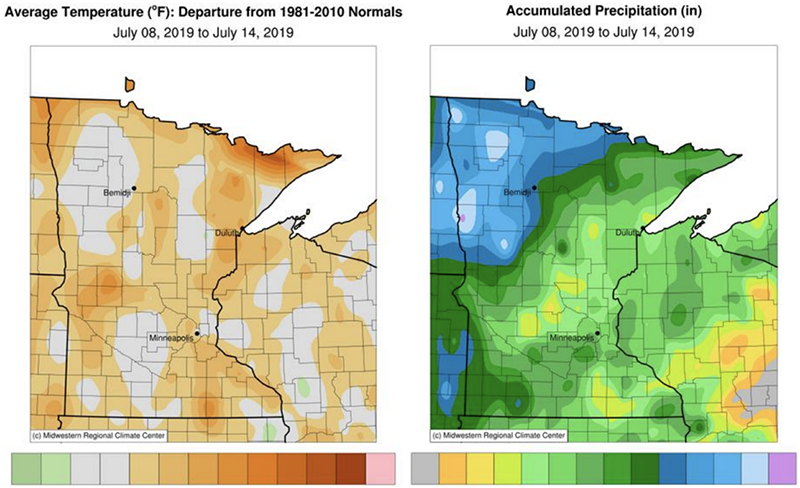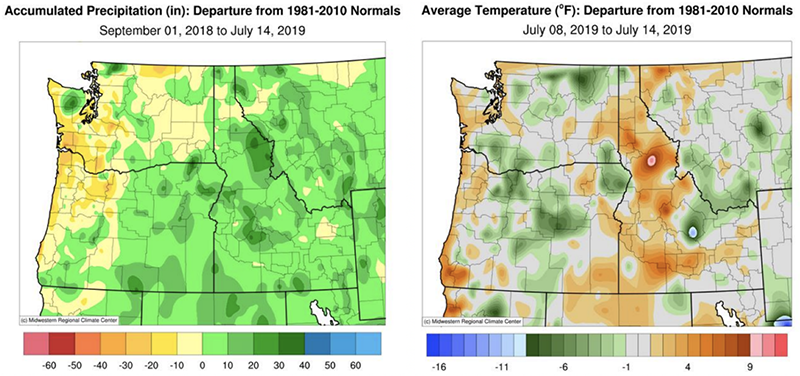July 18, 2019
During the week ending July 14th, pulse crops were mostly blooming and harvest began on early seeded peas in the Pacific Northwest.

For the most part, U.S. pulse crops are entering the blooming stage. In several of the key growing areas, the crop remains behind the average pace. This is especially the case in Michigan, where the tail end of the crop has yet to be seeded. In the Pacific Northwest, meanwhile, harvest has begun on the early-planted peas.
Michigan
Last week, weather conditions were hot and dry in this major black bean growing state. There were 6.4 days suitable for fieldwork, which allowed growers to nearly finish planting their dry bean crops. By the end of the week, 95% of the beans had been planted. The high temperatures helped the crop come up out of the ground, with emergence at 69%, behind the average of 97% for this time of year. The crop is late due to the planting delays caused by wet weather at the start of the seeding season. Crop condition ratings were 13% very poor to poor, 23% fair, 46% good and 18% excellent.
Minnesota
Minnesota is a key kidney bean growing state. The dry bean crop is fully emerged, with 18% of the plants blooming. That compares to the average of 42% for this time of the year. The crop is behind schedule because of rain delays during the planting window. The crop rates 6% very poor to poor, 30% fair, 53% good and 11% excellent.

Montana
Montana is a major producer of pulse crops. Top- and subsoil moisture levels rated 77% and 76% adequate to surplus, respectively. All pulse crops were emerged and blooming; 13% of dry beans (including chickpeas) were blooming and 89% of peas and 76% of lentils were blooming. The dry pea crop rated 6% very poor to poor, 32% fair, 54% good and 8% excellent. The lentil crop rated 4% poor, 43% fair, 46% good and 7% excellent.
North Dakota
North Dakota is the country’s top dry bean producing state. All pulse crops were planted. Top- and subsoil moisture levels rated 87% and 82% adequate to surplus, respectively. There were 4.8 days suitable for fieldwork. The dry bean crop condition rated 2% poor, 21% fair, 70% good and 7% excellent. 34% of the bean plants were blooming, near the average of 38%, and 1% were setting pods. The dry pea crop rated 2% poor, 19% fair, 73% good and 6% excellent. 84% of the pea plants were blooming, near the average of 86%, and 2% were dropping leaves.
Pacific Northwest
The Pacific Northwest is an important pulse producing region. Last week, the region received favorable weather for fieldwork across the board. The pea harvest got underway last week in the Pacific Northwest, with the following progress reported: 1% in Idaho; 4% in Oregon; and 2% in Washington. In Idaho, the pea crop rated 42% fair, 47% good and 11% excellent. In Oregon, it rated 20% very poor to poor, 22% fair, 32% good and 26% excellent. In Washington, the peas rated 1% poor, 8% fair, 85% good and 6% excellent. With respect to the dry bean crop, in Idaho it rated 43% fair, 49% good and 8% excellent. In Oregon, the beans rated 8% very poor to poor, 28% fair, 52% good and 12% excellent. In Washington, the crop rated 7% poor, 15% fair, 68% good and 10% excellent.
